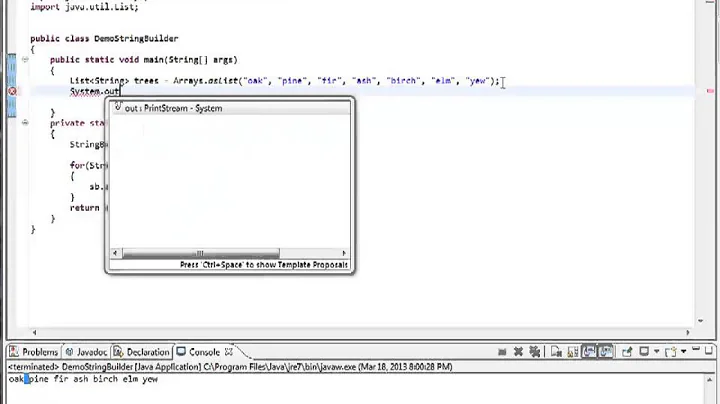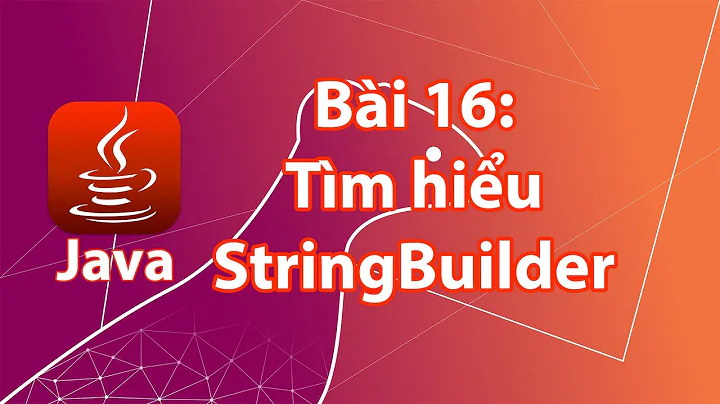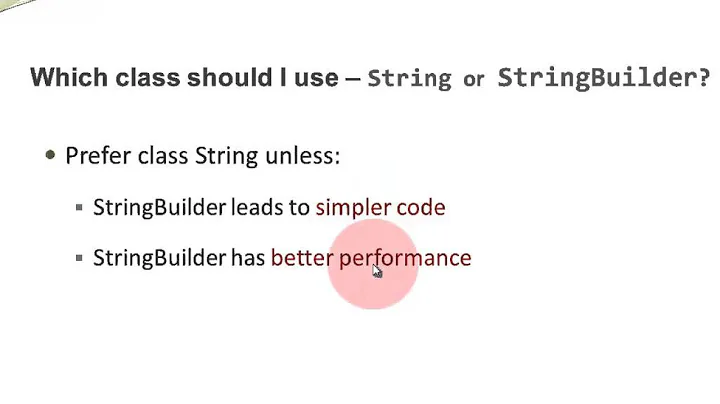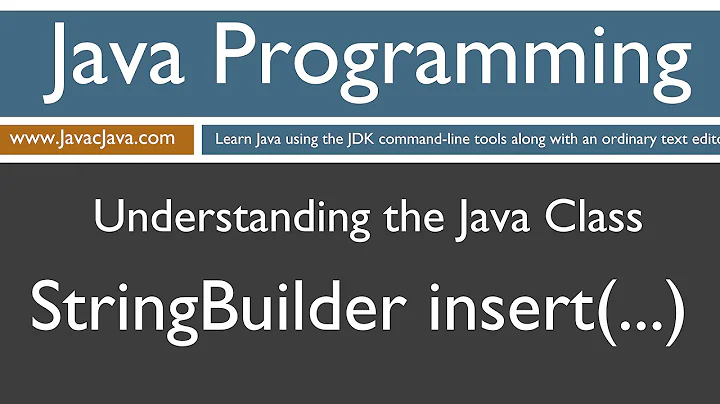java: use StringBuilder to insert at the beginning
Solution 1
StringBuilder sb = new StringBuilder();
for(int i=0;i<100;i++){
sb.insert(0, Integer.toString(i));
}
Warning: It defeats the purpose of StringBuilder, but it does what you asked.
Better technique (although still not ideal):
- Reverse each string you want to insert.
- Append each string to a
StringBuilder. - Reverse the entire
StringBuilderwhen you're done.
This will turn an O(n²) solution into O(n).
Solution 2
you can use strbuilder.insert(0,i);
Solution 3
Maybe I'm missing something but you want to wind up with a String that looks like this, "999897969594...543210", correct?
StringBuilder sb = new StringBuilder();
for(int i=99;i>=0;i--){
sb.append(String.valueOf(i));
}
Solution 4
As an alternative solution you can use a LIFO structure (like a stack) to store all the strings and when you are done just take them all out and put them into the StringBuilder. It naturally reverses the order of the items (strings) placed in it.
Stack<String> textStack = new Stack<String>();
// push the strings to the stack
while(!isReadingTextDone()) {
String text = readText();
textStack.push(text);
}
// pop the strings and add to the text builder
String builder = new StringBuilder();
while (!textStack.empty()) {
builder.append(textStack.pop());
}
// get the final string
String finalText = builder.toString();
Solution 5
This thread is quite old, but you could also think about a recursive solution passing the StringBuilder to fill. This allows to prevent any reverse processing etc. Just need to design your iteration with a recursion and carefully decide for an exit condition.
public class Test {
public static void main(String[] args) {
StringBuilder sb = new StringBuilder();
doRecursive(sb, 100, 0);
System.out.println(sb.toString());
}
public static void doRecursive(StringBuilder sb, int limit, int index) {
if (index < limit) {
doRecursive(sb, limit, index + 1);
sb.append(Integer.toString(index));
}
}
}
Related videos on Youtube
user685275
Updated on August 06, 2020Comments
-
user685275 almost 4 years
I could only do this with String, for example:
String str=""; for(int i=0;i<100;i++){ str=i+str; }Is there a way to achieve this with StringBuilder? Thanks.
-
entonio about 13 years...since it makes
AbstractStringBuildermove all the contents past the index of insertion in order to find room for the inserted ones. However, that's an implementation detail, not one of principle. -
user541686 about 13 years@entonio: Indeed, but it's a very critical detail. :)
-
user685275 about 13 yearsI see,It looks like I shouldn't be using StringBuilder then, Thanks a lot
-
user541686 about 13 years@user685275: Yeah, if you need backwards insertion then you really need something that can insert at the beginning of the string. I think the easiest solution is the technique above (reversing things twice), although you could probably make a better class of your own with char arrays (might want to look into "deque"s).
-
nom-mon-ir over 9 yearsStrange this post did not get much voting while providing the solution by clever manipulation of the loop,
-
 Raymond Chenon over 8 years@nom-mon-ir he just reversing the String. It doesn't answer how to append on the left.
Raymond Chenon over 8 years@nom-mon-ir he just reversing the String. It doesn't answer how to append on the left. -
Speck over 8 yearsAchieves the desired effect.
-
Luna over 8 years
ArrayDequeshould be used instead ofStack. "A more complete and consistent set of LIFO stack operations is provided by the {@link Deque} interface and its implementations, which should be used in preference to this class. " -
jorgeu almost 6 yearsAnother option when conditions are right is to use a linked list with addFirst and then use Collectors.joining(...) to create the desired string.
-
user541686 almost 6 years@jorgeu: It's difficult to overstate how extremely rare it is for a linked list to be a better choice here.
-
jorgeu almost 6 years@Mehrdad you sure you know what string builder is doing when you add at the begining? see stackoverflow.com/questions/26170180/…
-
user541686 almost 6 years@jorgeu: Yeah. I don't see anything in your link to the contrary either. And see here.
-
PhoneixS almost 6 yearsI think that there could be cases in which you can use this approach instead of trying to hack a way to do the insert on the beginning which uses the true potential of StringBuilder. Anyway, there are cases in which you can't reverse the loop so you need also the other answers.
-
 Akhil Surapuram over 5 years@Mehrdad I have tried your Better Technique. you should append string in a reverse way. else if you append 01 you will get 10 in final string
Akhil Surapuram over 5 years@Mehrdad I have tried your Better Technique. you should append string in a reverse way. else if you append 01 you will get 10 in final string -
user541686 over 5 years@AkhilSurapuram: That's what I mentioned in step #1, right?
-
 Akhil Surapuram over 5 years@Mehrdad sorry I meant to say you also need to reverse the string builder before inserting reversed strings.
Akhil Surapuram over 5 years@Mehrdad sorry I meant to say you also need to reverse the string builder before inserting reversed strings. -
user541686 over 5 years@AkhilSurapuram: Isn't the string builder empty initially?
-
rogerdpack about 5 yearsHmmm...the "purpose" of StringBuilder? Seems from the javadocs its "purpose" is to act as a mutable string, its "typical benefit and use" is to avoid the N^2 append loops, definitely? In this case it reintroduces an N^2 loop, but with input size of "only" 100, might still be acceptably fast to just do
insert(0, )'s depending on how often, perhaps... :) -
user541686 about 5 years@rogerdpack: I'd say that's the mechanism, not the purpose. The purpose is to be asymptotically faster than string manipulation, which it won't be if you use it wrong.
-
 JGFMK over 4 yearsWhy did this get so many likes! The class is not defined correctly - only the signature of the method call!
JGFMK over 4 yearsWhy did this get so many likes! The class is not defined correctly - only the signature of the method call! -
 bad_coder about 4 yearsWelcome to stackoverflow. Please include an explanation of what the code does and how it solves the problem in the question.
bad_coder about 4 yearsWelcome to stackoverflow. Please include an explanation of what the code does and how it solves the problem in the question.







